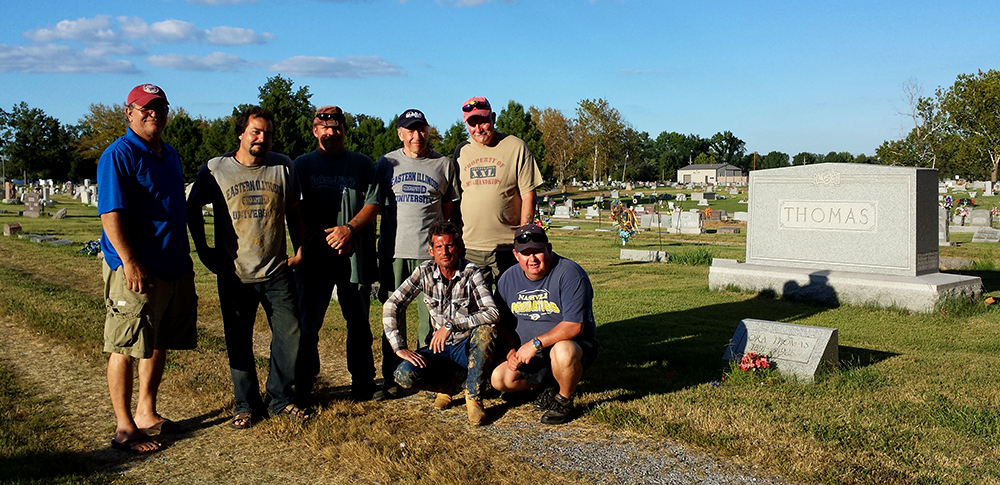
Examining a cemetery and digging through graves isn’t what most people consider a pastime, but for Steven Di Naso, it’s been part of his daily life for four years now.
Di Naso, a director of the EIU Geographic Information Science Center and faculty member in the Department of Geology and Geography, isn’t alone; he and four other men are conducting research at the Herrin City Cemetery in southern Illinois to find where victims of the 1922 Herrin Massacre, a deadly confrontation between union and non-union coal miners that resulted in 16 brutal deaths, are actually buried.
The Massacre is a thought that has been buried for almost nine decades now, but Di Naso and his group have actively been researching and working on this project not just for the closure of their research, but more so for closure for the men who never got it.
Beginning the research
The group’s research initially started when Scott Doody, a Williamson County historian and principal investigator of the project, wanted to write a book on the Herrin Massacre but found there was really no literature on the event. He then found when searching for a grave marker for victim Anton Malkovich that there was none. Doody then reached out to Di Naso and Vincent Gutowski, a Geography and Geology faculty member; student Grant Woods, a GIS specialist; and Sheriff John Foster, genealogist and research scientist, to find out where the victims are buried.
They came to the idea that these men were in fact buried in the Herrin City Cemetery, but, because of the controversy, were wiped off the record books or were never recorded.
Want to Know More?
Make sure you check out Scott Doody's Herrin Massacre website, which includes photos and videos related to the project along with ordering information for his book and a compilation of the project's coverage in local media.
Also, make sure you take a look at Scott's blog for updates related to the group's research.
The group thinks the victims were put in the “potter’s field,” an area reserved for people who couldn’t afford funerary services, and an area typically reserved for the unwanted, the unknown, and the unidentified. The people buried in the potter’s field usually didn’t receive much more than a wooden vault, sometimes, a slab of concrete etched with a nail, or, more often, no marker of any kind.
Given their unjust murders, some of which included being hanged, shot point-blank, or being dragged down a gravel road behind a Model T Ford, the group wants to give the massacre victims a proper burial. Most importantly, they would like to mark the graves of several WWI Veterans who lie in these unmarked graves.
Doing this research isn’t something they take lightly. Di Naso alone has documents upon documents filling up his computer, from biographies on the Massacre victims to the hundreds of GIS maps of the 25 acre cemetery they’ve developed.
“It’s been four years of a lot of data crunching,” he said. “It’s been very comprehensive in terms of our approach.”
The digging process
Di Naso and his group members from Eastern make the two-hour drive down to Herrin to do the digs and, using spatio-temporal analysis -- a study of place and time -- they evaluate the cemetery for explicit burial patterns that coincide with their belief the men are buried in the potter’s field.
They’ve also been examining a series of photographs they’ve gathered from newspaper coverage from the Massacre, which, at the time, made national headlines. They study the photographs that are all taken of the area in which the victims are most likely buried, but at different vantage points, and try to piece information together like a jigsaw puzzle.
Through their methods, they’ve already found an empty vault, which Di Naso said was a good indicator because the vault was made from high-quality oak, something they know was used for the massacre victims’ vaults. They also found an intricate coffin screw and an embalming fluid bottle during their dig -- which may be confirmation this very well could have been one vault among the five known disinterment’s, among the 16 vaults for which they are searching.
In their next dig, they’re hoping to find a similar vault in the same area, something he said will give the group conclusive proof the Herrin Massacre victims are in this area of the cemetery.
Bringing it back to the classroom
For Di Naso, incorporating his research back into the classroom is just as important as the completing the research itself.
He doesn’t use textbooks in his classes; instead, he uses real research findings for a highly integrative and interdisciplinary learning experience. For Herrin Massacre project, he brings the data he has collected into the classroom, and teaches the students how to spatially analyze these data to determine where the potter’s field is, and, consequently, the massacre victims are buried.
He said this learning style provides students with the academic rigor they will someday use in the real world.
“It’s about bringing in maps, it’s about bringing in the data,” he said, “It’s about doing the geospatial analysis and figuring out how that fits into this.”
Di Naso said they’ve also made the project interdisciplinary by bringing in historians, anthropologists, and archeologists to collaborate on the project.
All these components and different perspectives bring them one step closer to finalizing their search.
“When you put all the elements together, you’re kind of peering beneath the ground, which is kind of cool,” he said.
And while they haven’t solved the puzzle of the cemetery just yet, Di Naso said he believes it won’t be long until the Herrin Massacre victims are found and honored.
“I’m confident we’ll find them,” he said. “It’s just a matter of time.”









